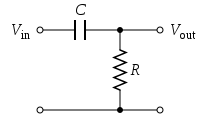That's good math work, safri, but the equation to use is different and far simpler.
Notice how all LCR meters use a specific freuquency for a range of C or L, that's roughly how this works.




Resistor here is a constant, use any thin film or carbon composite. Don't use wirewound as its a inductor too.
Now, put your unknown capacitor or inductor in the circuit above, as necessary.
Get a function or audio generator generator as Vin, and measure its output Voltage with a scope for say 500kHz or 500 Hz, just to copy the frequencies the device in the original post used. Say adjust it for 1 Vp-p so its easy to read.
If your cap is as big as your pinky or your inductor is fairly large, use the 500 Hz.
Now connect the generator to Vin and the scope to Vout. Adjust the output frequency precisely until the output voltage is 0.707Vp-p. That's the fc.
Now that you have fc, substitute it algebraically into the equation and that's your L or C.
Units:
fc= Hz
R = ohms
C = farads
L = henry
For example, you have an unknown small inductor.
Use the inductor high pass circuit above. You have some resistor lying around that is 500,000 ohms.
You pass 500kHz into it and it comes out 1V p-p. Adjusting frequency down [ since its a high pass filter its already passing everything ABOVE the cutoff] , at 300kHz the Vout is 0.707 p-p.
Solving:
L = R / 2 x pi x fc
L = 500,000 / 2 x pi x 300,000 Hz
L = 0.265 H or 265 mH.
As alm and I suggested in a old post, most hobbyist only need a good scope, like the Rigol 1052E, a function generator, a good DMM and PSU. An LCR meter is nice to have, but if you don't measure C or L often, and a good DMM comes with C meter already too, you can rig one up fairly quickly and get very accurate results with it.
Some modifications of the same rig can calculate ESR, DF, and Q too. But they can be more tedious to do on-the-fly, so it would be worth it to buy or build an ESR meter than a LCR meter without ESR built in.
http://octopus.freeyellow.com/esr.html